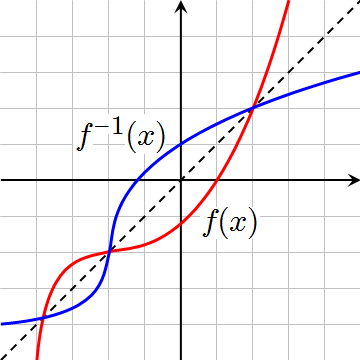2.6 KiB
MATH 117: Calculus 1
Functions
A function is a rule where each input has exactly one output, which can be determined by the vertical line test.
!!! definition - The domain is the set of allowable independent values. - The range is the set of allowable dependent values.
Functions can be composed to apply the result of one function to another. \[ (f\circ g)(x) = f(g(x)) \]
!!! warning Composition is not commutative: \(f\circ g \neq g\circ f\).
Inverse functions
The inverse of a function swaps the domain and range of the original function: \(f^{-1}(x)\) is the inverse of \(f(x)\).. It can be determined by solving for the other variable: \[ \begin{align*} y&=mx+b \\ y-b&=mx \\ x&=\frac{y-b}{m} \end{align*} \]
Because the domain and range are simply swapped, the inverse function is just the original function reflected across the line \(y=x\).
 (Source:
Wikimedia Commons, public domain)
(Source:
Wikimedia Commons, public domain)
If the inverse of a function is applied to the original function, the original value is returned. \[f^{-1}(f(x)) = x\]
A function is invertible only if it is “one-to-one”: each output must have exactly one input. This can be tested via a horizontal line test of the original function.
If a function is not invertible, restricting the domain may allow a partial inverse to be defined.
!!! example
(Source:
Wikimedia Commons, public domain) By restricting the domain to
\([0,\inf]\), the multivalued
inverse function \(y=\pm\sqrt{x}\) is reduced to just the
partial inverse \(y=\sqrt{x}\).
Symmetry
An even function satisfies the property that \(f(x)=f(-x)\), indicating that it is unchanged by a reflection across the y-axis.
An odd function satisfies the property that \(-f(x)=f(-x)\), indicating that it is unchanged by a 180° rotation about the origin.
The following properties are always true for even and odd functions:
- even × even = even
- odd × odd = even
- even × odd = odd
Functions that are symmetric (that is, both \(f(x)\) and \(f(-x)\) exist) can be split into an even and odd component. Where \(g(x)\) is the even component and \(h(x)\) is the odd component: \[ \begin{align*} f(x) &= g(x) + h(x) \\ g(x) &= \frac{1}{2}(f(x) + f(-x)) \\ h(x) &= \frac{1}{2}(f(x) - f(-x)) \end{align*} \]
!!! note The hyperbolic sine and cosine are the even and odd components of \(f(x)=e^x\). \[ \cosh x = \frac{1}{2}(e^x + e^{-x}) \\ \sinh x = \frac{1}{2}(e^x - e^{-x}) \]